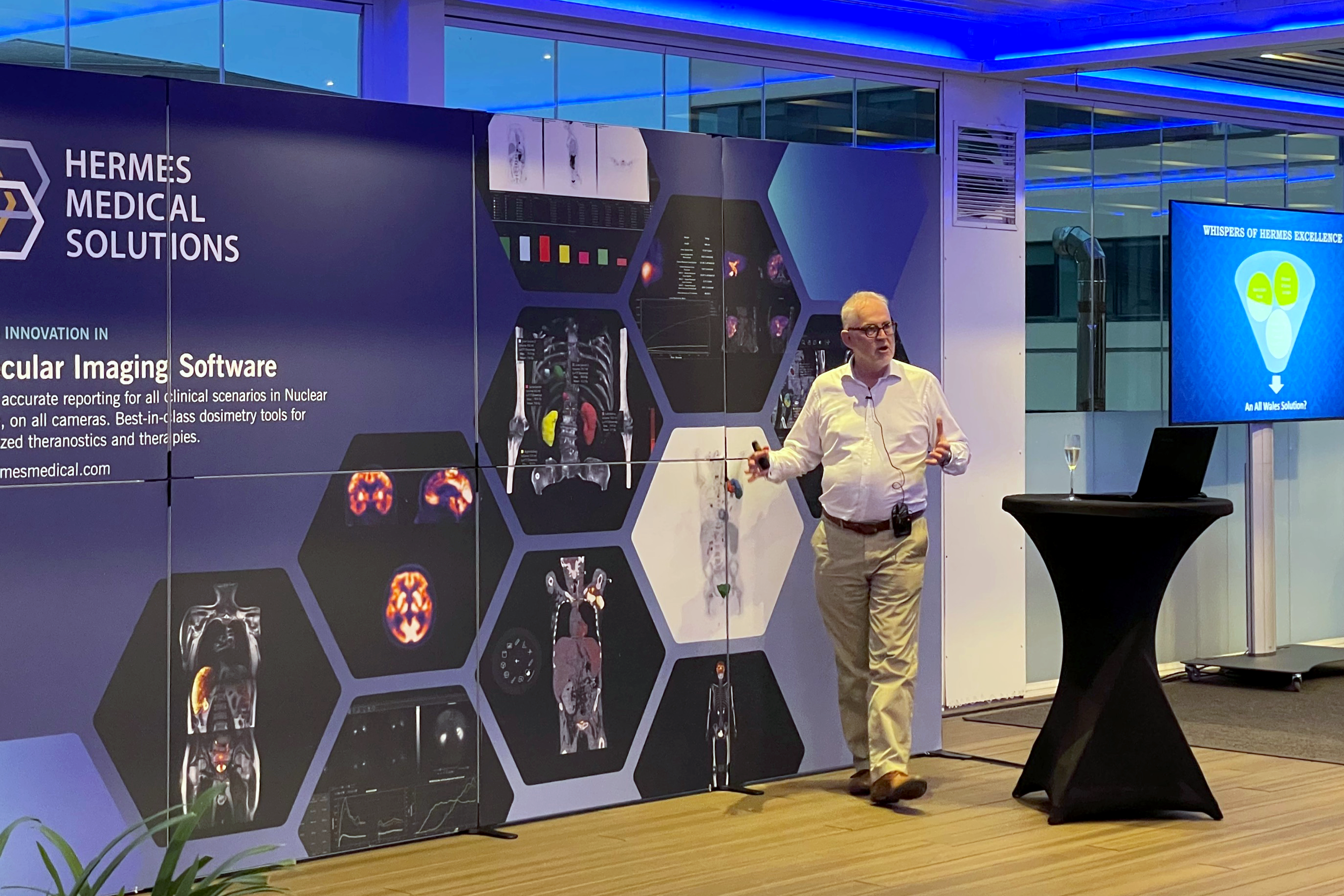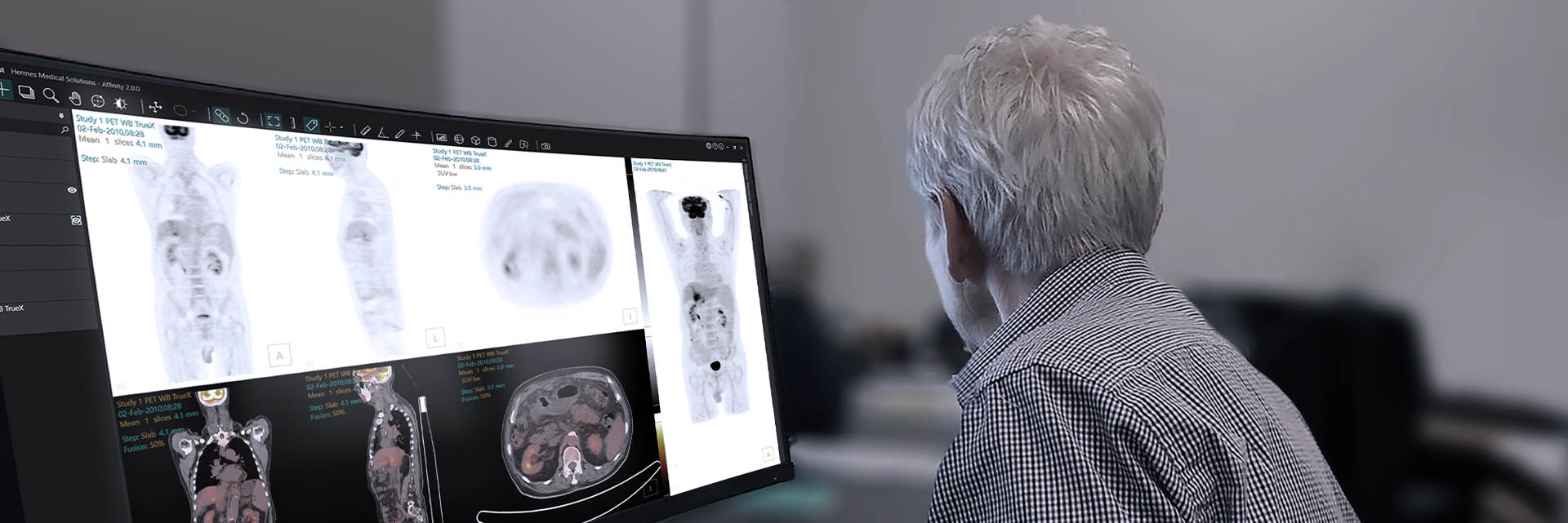Cutting-edge Nuclear Medicine, seamless connectivity and collaboration across sites: a vision coming together at Swansea Bay
Interview with Professor Neil Hartman, Head of Nuclear Medicine at Singleton Hospital

Prof. Neil Hartman
Singleton Hospital, Swansea, Wales, UK has recently installed a comprehensive Hermes Medical Solutions software facility as part of an extensive redevelopment of its nuclear medicine department. We asked Professor Hartman, Head of Nuclear Medicine at Singleton, who has enjoyed a long career in leading nuclear medicine centres in Canada and the UK, how Hermes Medical Solutions has supported his work over the years, and how its new Hermia software suite will help deliver molecular imaging diagnostics and radionuclide therapies at Singleton Hospital and across Swansea Bay Health Board.
“Singleton Hospital is a large academic hospital right next door to Swansea University in south Wales. With Morriston Hospital and Neath-Port Talbot Hospital, we form part of a bigger group of three hospitals that serve middle/southwest Wales”, he explains.
Good day at Singleton Hospital
“On a very good day at Singleton Hospital, we would scan 20 PET/CT patients, including PSMA PET scans. We would also scan 25-30 SPECT patients, a number [of whom] would successfully undergo myocardial perfusion [scans]. We also provide a DEXA service for bone-marrow densitometry in southwest Wales – we have a mobile scanner and a static scanner, so would scan another 30-40 people.”
Seamless transfer of data and images
With so many patients visiting the nuclear medicine department each day, careful planning is essential before the patient arrives at the hospital as well as during the procedures. Data from the scans of anywhere between 60 and 80 patients per day must be collected, analyzed, and reported as quickly, securely, and accurately as possible. “A medical software company like Hermes Medical Solutions can help overcome [these] challenges [by providing] the smooth operation of data and images. I started my career at departments with software from Hermes Medical Solutions, and we now have it here in Swansea. I turn to Hermes Medical Solutions for seamless transfer of data – correct data – from scanner to the terminal for us to be able to report.”
“We had five or six SPECT scanners, two cardio PET scanners, and our department had a private clinic. Hermes Medical Solutions brought all of this together.”
Improving the way of working
“Back in Ottawa, we had five or six SPECT scanners, two cardio PET scanners, and our department had a private clinic. Hermes Medical Solutions brought all of this together. It meant that consultants didn’t have to rush from site to site to look at scanner terminals. They could be at another location – frequently even from their homes on a Saturday morning – and report scans. This was also the case at St Bart’s, one of the biggest NHS hospitals in England, where we brought the four major hospital sites (St Bartholomew’s, The Royal London, Whipps Cross and Newham) together with Hermes Medical Solutions software. Now that I am at Singleton Hospital, we plan to connect the three sites that make up the Swansea Bay University Health Board. [We hope] our colleagues at the other two hospitals (Morriston Hospital and Neath Port Talbot Hospital) will join us and share data – because we believe in Hermia.”
Transforming the department and clinical services
“Singleton Hospital used to be the hospital in the UK with the oldest scanners, and we have recently purchased brand new scanners. We are one of the first hospitals in the UK to have the new StarGuide scanner from GE. I am also an honorary professor at the Faculty of Medicine of the university, and we really want to transform our department and clinical services in terms of the type of things we look at, and connectivity in general – from people’s home offices to the various terminals in the department. We are significantly developing nuclear medicine and PET provision via the Swansea Bay University Health Board."
"My goal is that any physician, radiologist, oncologist, or cardiologist, should be able to look at scans from three sites, and manipulate them from wherever they are."
"This depends on interactions among our nuclear medicine technologists and our physicists. In doing so, we want to avoid being just another nuclear medicine department using Hermia software from Hermes Medical Solutions. Rather, we want to be the cutting-edge department using Hermia. We want to continue to challenge Hermes Medical Solutions (in a friendly way) in terms of technology and improve together.”
The Importance of Choosing Vendor-Neutral Independent Software
“The choice of software for reconstruction, viewing and reporting in the nuclear medicine department and vendor neutrality is critical. It’s number one, two, and three of important points to consider. All of us in healthcare want a procurement process that is quick and easy. Vendor neutrality is important when it comes to the software because we have GE hardware in my department but may buy a PET scanner from a non-GE vendor.
The most important criteria when it comes to choosing a new supplier of nuclear medicine equipment is timely and efficient patient diagnosis. Reliability of the Hermia software and support from Hermes Medical Solutions for updates – or making us acutely aware of any changes – is very important."
"In my career, I have never had a concern partnering with Hermes Medical Solutions. I like the fact that we can count on Hermes Medical Solutions to provide software that’s used at world-leading clinical centres. I like the intuitive nature of the Hermia software.”
All-Wales Molecular Therapy Group
“We currently do thyroid therapies and, during the past three months, have established an all-Wales molecular therapy group (of which I am one of the founding members) and we are working terribly hard on getting prostate therapy possibly rolled out even before the end of this calendar year. I believe personalized dosimetry for every patient undergoing radionuclide therapies should be the norm and this will be reliant on the [Hermia] software package we use (how easy it is), as well as professional standards.”
On being asked how he envisions Nuclear Medicine in five years from now, Prof Hartman concludes: “PET is growing in Wales at 20- 25% per annum, SPECT is growing 2-3%, and I think we will see a much-increased role going forward for artificial intelligence. I am hopeful that our partnership with Hermes will stand us in good stead for the future.”

